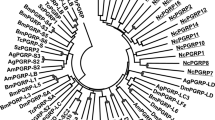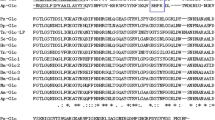Abstract
Peptidoglycan recognition proteins (PGRPs) are non-specific immune molecules of insects, and vertebrates etc., but are not present in plants and nematodes. In the current experiment, a PGRP DNA sequence (2,910 bp containing four exons) was identified from genomic DNA library of Asian corn borer, Ostrinia furnacalis, and a full-length cDNA programming PGRP was cloned (designed as OfPGRP-S) with an open reading frame of 579 bp, having 192 amino acid. This inferred amino acid sequence showed maximum similarity to known lepidopteran PGRPs. Quantitative real-time PCR investigation disclosed the level of mRNA of OfPGRP-S to be constitutively expressed in the whole developmental stages and with higher expression in the mature larvae. Even more the OfPGRP-S was mainly expressed in immune capable organs i.e., fat body and midgut, and was strongly induced by injecting gram-positive bacteria i.e., Staphylococus aureus. Recombinant protein OfPGRP-S could bind to S. aureus and Bacillus thuringiensis which enhance proPO activation in the presence of these microbes. The results indicated that OfPGRP-S is an inducible protein acting as a receptor-type PGRP for enhancing the proPO activation on exposure to bacteria.







Similar content being viewed by others
References
Bischoff V, Boneca VC, Michel IG, Hoffmann T, Royet JA (2004) Function of the drosophila pattern-recognition receptor PGRP-SD in the detection of Gram-positive bacteria. Nat Immunol 5:1175–1180
Dziarski R, Gupta D (2006) The peptidoglycan recognition proteins (PGRPs). Genome Biol 7:232
Garver LS, Wu J, Wu LP (2006) The peptidoglycan recognition protein PGRP-SC1a is essential for toll signaling and phagocytosis of Staphylococcus aureus in Drosophila. Proc Natl Acad Sci USA 103:660–665
Gelius E, Persson C, Karlsson J, Steiner H (2003) A mammalian peptidoglycan recognition protein with N-acetylmuramoy l-alanine amidase activity. Biochem Biophy Res Commun 306:988–994
Gillespie JP, Kanost MR, Trenczek T (1997) Biological mediators of insect immunity. Annu Rev Entomol 42:611–643
Gupta D, Kirkland TN, Viriyakosol S, Dziarski R (1996) CD14 is a cell-activating receptor for bacterial peptidoglycan. J Biol Chem 271:23310–23316
Hoffmann JA (2003) The immune response of Drosophila. Nature 426:33–38
Hultmark D (1993) Immune reactions in Drosophila and other insects: a model for innate immunity. Trends Genet 9:178–183
Inohara N, Ogura Y, Nunez G (2002) Nods: a family of cytosolic proteins that regulate the host response to pathogens. Curr Opin Microbiol 5:76–80
Kaneko T, Yano T, Aggarwal K, Lim JH, Ueda K, Oshima Y, Peach C, Erturk-Hasdemir D, Goldman WE, Oh BH (2006) PGRP-LC and PGRP-LE have essential yet distinct functions in the drosophila immune response to monomeric DAP-type peptidoglycan. Nat Immunol 7:715–723
Kang D, Liu G, Lundstrom A, Gelius E, Steiner H (1998) A peptidoglycan recognition protein in innate immunity conserved from insects to humans. Proc Natl Acad Sci USA 95:10078–10082
Lee MH, Osaki T, Lee JY, Baek MJ, Zhang R, Park JW, Kawabata S, Derh LK, Lee BL (2004) Peptidoglycan recognition proteins involved in 1, 3-β-d-glucan-dependent prophenoloxidase activation system of insect. J Biol Chem 279:3218–3227
Lemaitre B, Hoffmann J (2007) The host defense of Drosophila melanogaster. Annu Rev Immunol 25:697–743
Lim JH, Kim MS, Kim HE, Yano T, Oshima Y, Aggarwal K, Goldman WE, Silverman N, Kurata S, Oh BH (2006) Structural basis for preferential recognition of diaminopimelic acid-type peptidoglycan by a subset of peptidoglycan recognition proteins. J Biol Chem 281(12):8286–8295
Liu C, Xu Z, Gupta D, Dziarski R (2001) Peptidoglycan recognition proteins: a novel family of four human innate immunity pattern recognition molecules. J Biol Chem 276:34686–34694
Medzhitov R, Janeway CA (2002) Decoding the patterns of self and non self by the innate immune system. Science 296:298–300
Mellroth P, Steiner H (2006) PGRP-SB1: an N-acetylmuramoyl l-alanine amidase with antibacterial activity. Biochem Biophys Res Commun 350:994–999
Mellroth P, Karlsson J, Steiner H (2003) A scavenger function for a Drosophila peptidoglycan recognition protein. J Biol Chem 278:7059–7064
Michel T, Reichhart JM, Hoffmann JA, Royet J (2001) Drosophila toll is activated by gram-positive bacteria through a circulating peptidoglycan recognition protein. Nat Rev Immunol 2:756–759
Ono H, Matsumoto A, Hashimoto K, Yamano Y, Morishima I (2007) Peptidoglycan recognition protein (PGRP) from eri-silkworm, Samia cynthia ricini; protein purification and induction of the gene expression. Comp Biochem Physiol B Biochem Mol Biol 147:512–519
Schleifer KH, Kandler O (1972) Peptidoglycan types of bacterial cell walls and their taxonomic implications. Bacteriol Rev 36:407–477
Sumathipala N, Jiang H (2010) Involvement of Manduca sexta peptidoglycan recognition protein-1 in the recognition of bacteria and activation of prophenoloxidase system. Insect Biochem Mol Biol 40:487–495
Takehana A, Katsuyama T, Yano T, Oshima Y, Takada H, Aigaki T, Kurata S (2002) Overexpression of a pattern-recognition receptor, peptidoglycan-recognition protein-LE, activates imd/relish-mediated antibacterial defense and the prophenoloxidase cascade in Drosophila larvae. Proc Nat Acad Sci USA 99:13705–13710
Takeuch O, Akira S (2001) Toll-like receptors; their physiological role and signal transduction system. Int Immunopharm 1:625–635
Wang ZM, Li X, Cocklin RR, Wang M, Fukase K, Inamura S, Kusumoto S, Gupta D, Dziarski R (2003) Human peptidoglycan recognition protein-L is an N-acetylmuramoyl-l-alanine amidase. J Biol Chem 278:49044–49052
Werner T, Liu G, Kang D, Ekengren S, Steiner H, Hultmark D (2000) A family of peptidoglycan recognition proteins in the fruit fly Drosophila melanogaster. Proc Nat Acad Sci USA 97:13772–13777
Werner T, Borge-Renberg K, Mellroth P, Steiner H, Hultmark D (2003) Functional diversity of the Drosophila PGRP-LC gene cluster in the response to lipopolysaccharide and peptidoglycan. J Biol Chem 278:26319–26322
Yoshida H, Kinoshita K, Ashida M (1996) Purification of a peptidoglycan recognition protein from hemolymph of the silkworm, Bombyx mori. J Biol Chem 271:13854–13860
You H, Wan H, Jianhong L, Byung RJ (2010) Molecular cloning and characterization of a short peptidoglycan recognition protein (PGRP-S) with antibacterial activity from the bumblebee Bombus ignites. Dev Comp Immunol 34:977–985
Yu XQ, Zhu YF, Ma C, Fabrick JA, Kanost MR (2002) Pattern recognition proteins in Manduca sexta plasma. Insect Biochem Mol Biol 32:1287–1293
Zhou DR, Wang YY, Liu BL, Ju ZL (1980) Research on the reproduction of Ostrina furnacalis in a large quantity: an artificial diet and its improvement. J Plant Prot 7:113–122
Acknowledgments
This work was supported by grant from the National Natural Science Foundation of China (31071734; 30900943) and the National Postdoctoral Foundation of China (20080430838).
Author information
Authors and Affiliations
Corresponding author
Additional information
Qiang Sun and Xiao-Xia Xu have contributed equally to this work.
Rights and permissions
About this article
Cite this article
Sun, Q., Xu, XX., Freed, S. et al. Molecular characterization of a short peptidoglycan recognition protein (PGRP-S) from Asian corn borer (Ostrinia furnacalis) and its role in triggering proPO activity. World J Microbiol Biotechnol 30, 263–270 (2014). https://doi.org/10.1007/s11274-013-1449-3
Received:
Accepted:
Published:
Issue Date:
DOI: https://doi.org/10.1007/s11274-013-1449-3




